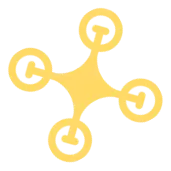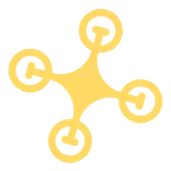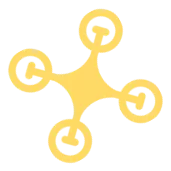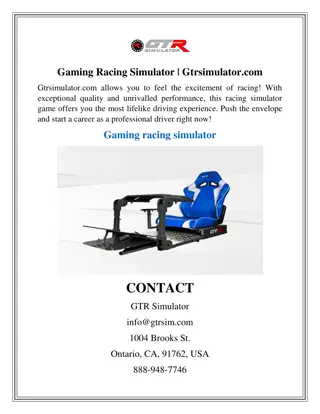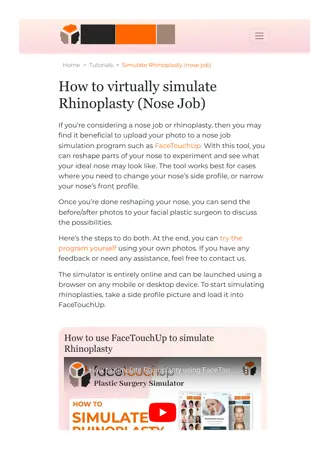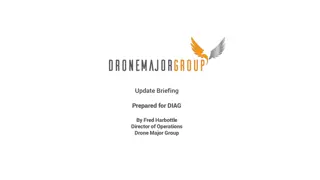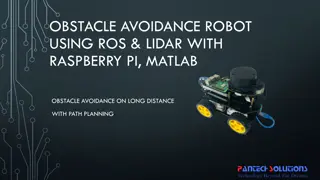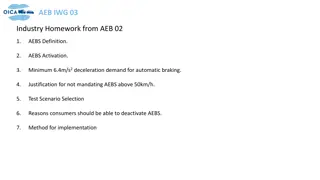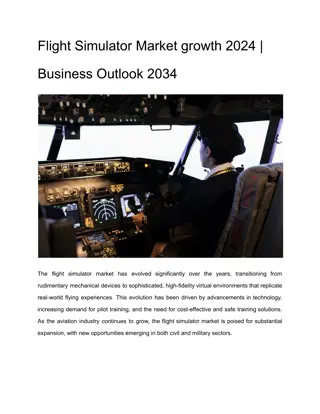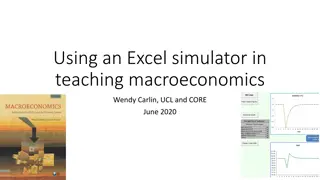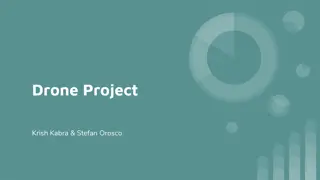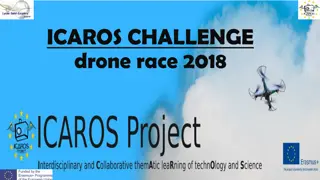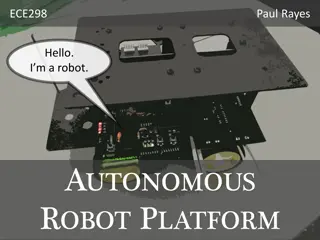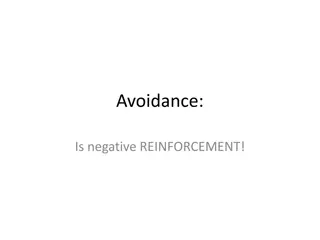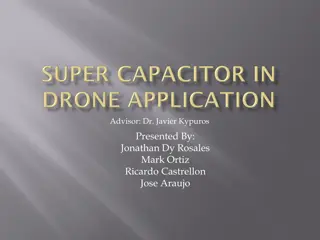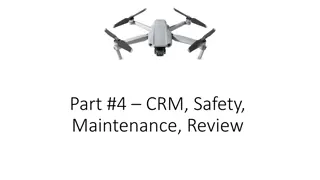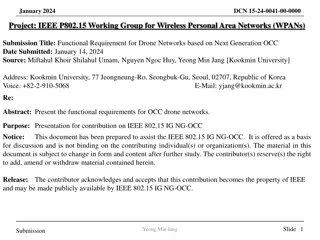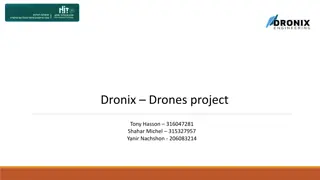Drone Collision Avoidance Simulator for Autonomous Maneuvering
Our project focuses on developing a drone collision avoidance simulator using NEAT and Deep Reinforcement Learning techniques. We aim to create a model that can maneuver obstacles in a 2D environment, enhancing performance and survivability. Previous attempts utilizing non-machine learning solutions and deep learning have shown promise, with potential for significant advancements in the field of autonomous drone navigation.
Download Presentation

Please find below an Image/Link to download the presentation.
The content on the website is provided AS IS for your information and personal use only. It may not be sold, licensed, or shared on other websites without obtaining consent from the author. Download presentation by click this link. If you encounter any issues during the download, it is possible that the publisher has removed the file from their server.
E N D
Presentation Transcript
Drone Collision Avoidance Simulator Group 69 Kaustubh Lall Kevin Youssef Varun Malik
01 Introduction and Motivation
Background and Motivation Obstacle avoidance is an important task in the field of Robotics Autonomous Drones used in the Defense Industry Automatic Motion Tracking -- Cinematography Software simulations as Proof of Concept Stakeholder Buy-in Save $$$ Polish Code Implementation and Logic
Background and Motivation Complexity in real life models leads to difficulty in use. Generalizing problem to different resolutions or scales is difficult with traditional ML. NEAT provides a way to develop lightweight networks with arbitrary structures which are task-optimized and can be extended with HyperNEAT to tackle tasks at different input scales for visual applications.
Problem Formulation We want to create a model that can maneuver an obstacle course We will only consider 2 dimensions (X,Y) of motion used to avoid obstacles in 1 dimension (X) Performance is defined to be the amount of time the player survives without crashing
02 Literature Survey
Previous Attempts The first approaches to this issue were using non machine learning solutions While deep learning is able to solve this problem, it is slow to train and converge and takes a relatively large number of parameters making it slow in practice. Simultaneous Localization And Mapping (SLAM) is a method that uses sensors to build a map of the environment and determine the drone s location in that map, and serves as proxy for relating our simulation from virtual to real-world.
Previous Attempts There have been previous ML approaches to solving this issue Deep Reinforcement Learning was used using a U-net which gave performance comparable to that of an expert pilot on different 3D objects(Cones, Cubes, Spheres) (Simulated) Q-network Deep Reinforcement Learning with some drones as obstacles to tackle stationary and moving obstacles. Achieved almost 98% success rate
How We Are Different Our main approach is still using Reinforcement Learning Instead of Q-Net or U-Net, we use NeuroEvolution of Augmentation Topology (NEAT) Due to time and resource constraints, we are simulating and only in 2 degrees of freedom in turn of motion or obstacles (horizontally and vertically) We also add food which can incentivise drone to choose one path over another, as well as introduce additional complexity to the problem to promote structural development.
03 The Simulator
Dataset We did not want to collect real-world data as it is difficult, noisy and hard work with. We are generating our data via a simulation instead and engineering our features from it.
Feature Extraction We are capable of viewing the simulation top-down, which is unrealistic. Feature map could be 2-D input image of game state. Want to represent closer to life simulations, thus we must engineer features from simulation.
Feature Extraction We modeled each sensor with the following information shown in red:
Deep Dive ! Drone Food Sensed The bottom right sensor detected food Obstacle Sensed Three sensors sense obstacles in their respective quadrants
Deep Dive Used PyGame to simulate the game. Used NEAT-Python to write Ai code. Game implements a drone with velocity, acceleration and uniform drag (dampening), but no momentum or mass. Food randomly moves to stimulate work for reward.
04 Our Machine Learning Model
Genetic Model Fitness Limited Visibility Survival time in seconds Field of View is limited Sensors Eating Food adds 10 seconds 4 sensors per player One in each quadrant
Genetic Model Fitness is the maximum time a player in a species survives Eating food adds 10 seconds to fitness score 4 sensors per player, one per quadrant relative to player Player gets limited region of visibility for each sensor
IN DEPTH NEAT Combines a deep-learning approach with reinforcement learning and uses agents with a defined neural network structure. These agents are classified into species based on their similarities and a reinforcement algorithm that simulates natural selection is used to select the best species and pass its traits into the next generation for training.
05 Results and Observations
Results First model we used had low node creation and deletion probabilities, which caused model to be too slow and did not converge in time. Second model had higher node creation and deletion probabilities and increased mutation parameter. This caused the model fitness to oscillate Final model was same as second model but with shortened sensor regions and higher vertical acceleration which allowed the model to finally reach 2 minutes of survival
Results 1st Model 2nd Model 3rd Model Fitness 16.8 51.4 120 Terminated at 300 Terminated at 300 Converged at 201 Generation * Used 120 as Fitness threshold
Conclusions Model with low mutation and node creation and deletion rates makes model not converge quickly enough 2 main final species: one is food obsessed and reckless, one is more safe and ignores food. Second outperforms the first. Making sensor region too large overwhelmed the drone. By giving sensor smaller area, drone can focus on avoiding each obstacle on its own
06 Next Steps and References
Next Steps Documentation Write final report
References Kober, Jens, and Jan Peters. Reinforcement Learning in Robotics: A Survey. Adaptation, Learning, and Optimization, 2012, pp. 579 610., doi:10.1007/978-3-642-27645-3_18. Stanley, K. O., D Ambrosio, D. B., & Gauci, J. (2009, April). A Hypercube-Based Encoding for Evolving Large-Scale Neural Networks. Artificial Life, 185 212. https://doi.org/10.1162/artl.2009.15.2.15202 Stanley, K. O., & Miikkulainen, R. (2002, June). Evolving Neural Networks through Augmenting Topologies. Evolutionary Computation, 99 127. https://doi.org/10.1162/106365602320169811 Ghaderi, Kayvan, et al. A New Digital Image Watermarking Approach Based on DWT- SVD and CPPN-NEAT. 2012 2nd International EConference on Computer and Knowledge Engineering (ICCKE), 2012, doi:10.1109/iccke.2012.6395344. https://miro.medium.com/max/1400/1*Neqg9wuBYfDPB7I9Wptmuw.png
Demo and Code Walkthrough CREDITS: This presentation template was created by Slidesgo, including icons by Flaticon, and infographics & images by Freepik.



